The AMD Llano Notebook Review: Competing in the Mobile Market
by Jarred Walton & Anand Lal Shimpi on June 14, 2011 12:01 AM ESTPower Gating
With 1.45 billion transistors on die, Llano relies on extensive power gating in order to keep things in order. The APU is split into two independent power islands: the CPU and the GPU. The memory controller and North Bridge both live on the GPU's power island. Each island has its own independent voltage source.
Everything from an individual CPU core to the entire GPU or virtually the entire APU package can be power gated. AMD provided photon recombination images to show the impact power gating the GPU can have on leakage current:
Although not depicted above, Llano can also fully power gate the x86 CPU cores or both the CPU and GPU if the entire APU is in a deep sleep state. Being able to completely power gate CPU cores or the GPU is an important part of enabling the next major feature of Llano: Turbo Core.
Turbo Core
All processors whether CPUs, GPUs or APUs have to be designed to strict thermal and power limits. OEMs need to know exactly what sort of chassis they'll be able to build around these chips and as a result the chip vendors provide guidance in the form of specifications, including the chip's thermal design point (TDP).
In the old days of microprocessors things were simple. You had a single core that ran all the time and it consumed all of the available thermal budget allocated for that core. AMD and Intel eventually enabled dynamic clock frequencies which let your single core underclock itself when it wasn't being used, which helped reduce power and extend battery life. Then came the multi-core era.
CPUs couldn't just start putting out twice as much heat now that they had two cores; instead, each core had to consume less power. The chip guys achieved this by running the cores at lower frequencies and voltages than they did in the single-core days. Two cores paved the way to four cores, which meant another reduction in clock speed per core. Sure we got much better multi-threaded performance, but for single-threaded applications performance wasn't as great as it could be. Users had to make a tradeoff: good multi-threaded performance or good single-threaded performance; you couldn't have both. Until power gating came along that is.
Without power gating you can never really shut off power to an idle core. The transistors aren't switching but power is still dissipated thanks to leakage current. Remember that transistors don't simply stop conducting electricity when they're off. The smaller they get, the more leaky our beloved transistors become. Power gating lets you physically block the flow of current to the transistors that are being gated, so when they're off, they're actually off. With an idle core shut off, now you have the extra TDP headroom to run any active cores at higher frequencies.
Intel does this with a technology it calls Turbo Boost. Intel looks at current draw and thermal sensors spread out all over the chip and determines when it has the available thermal headroom to turbo up any active cores. AMD implements a similar technology in Llano (and previously in their hex-core desktop parts) called Turbo Core.
I say similar but not identical because AMD's approach differs in a very important way. While Intel looks at current draw and temperature data, AMD looks at workload. Each activity within the Llano APU is assigned a certain power weight (e.g. an integer multiply is known to require a certain amount of power). Llano is aware of the operations it's currently working on and based on the weights associated with these operations it comes up with a general estimate of its power consumption on a per core basis. I mention this is an estimate because it correlates digital activity to power consumption; it doesn't actually measure power consumption.
Based on the number of events and their individual weights, AMD estimates the power consumption of each core and determines how much TDP headroom exists in the system. If the OS is requesting the highest p-state from the CPU and there's available TDP headroom, Llano will turbo up any active cores up to a maximum frequency. Like Sandy Bridge, Llano is able to temporarily exceed the APU's maximum TDP if it determines that the recent history of power consumption has been low enough that it'll take a while for the APU to ramp up to any thermal limits.
One major limit of Llano's Turbo Core is that the GPU can't turbo up in the event of the CPU cores being idle. Only the CPU cores can turbo up if they have available headroom. I suspect future versions of Llano will probably enable GPU Turbo Core as well:
It's unclear to me at this point what shortcomings or advantages exist for AMD's Turbo Core method vs. Intel's Turbo Boost. At the bare minimum the two are finally comparable although they use different approaches to attain a similar end result. AMD doesn't yet have a method of actually displaying Turbo Core frequencies, unfortunately, so we're operating a bit blind at this point. Over time I hope to have a better idea of how AMD's solution stacks up.


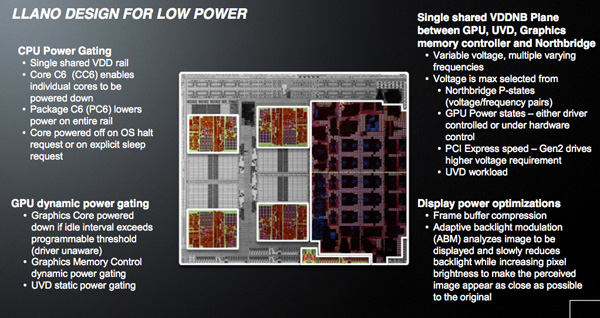
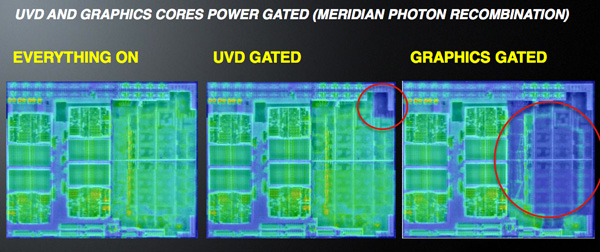
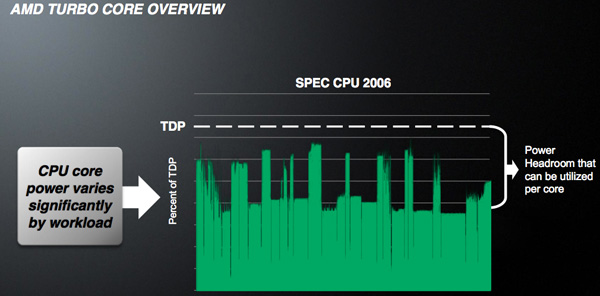
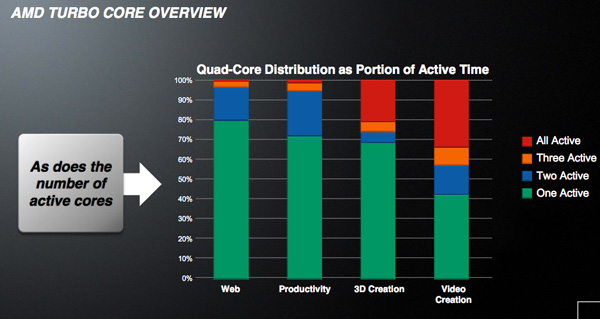
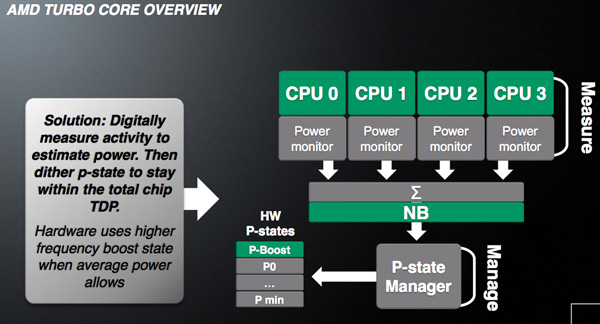
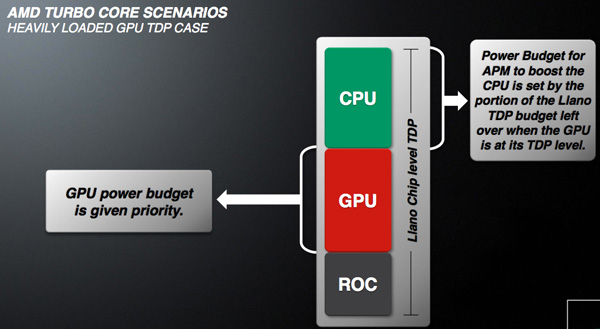
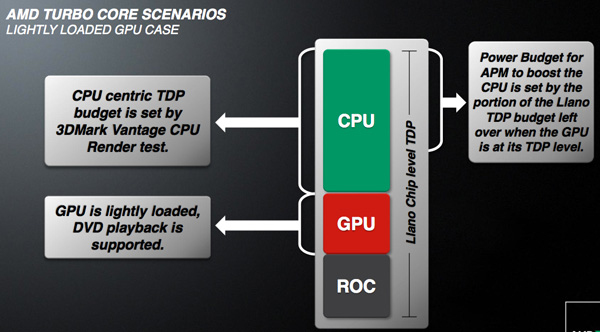








177 Comments
View All Comments
JarredWalton - Tuesday, June 14, 2011 - link
The only way to make sure that Intel's current processors aren't at the top of most charts is to leave them out, particularly on notebooks. If we only look at IGP/fGPU, AMD comes out on top of graphics charts, but is that fair to NVIDIA's Optimus technology that allows dynamic switching between IGP and dGPU in a fraction of a second? The overall tone of this article (apart from the CrossFire section) is positive, but still people look at the charts and freak out because we didn't manipulate data to make Llano look even better. It's not bad, but it's certainly not without flaws.kevith - Tuesday, June 14, 2011 - link
Oh too bad.I would like to use a laptop for music production with Nuendo and Win 7.
It actually reqires a little more graphics-musclle than you might think to run an app like Nuendo.
And,up to now, it has not been possible to get both a powerful CPU and GPU in the same machine for the money I have.
So now the fGPU is powerful enough, that's great. But it seems, that the CPU-part of these APU's are too weak.
Øv...
krumme - Tuesday, June 14, 2011 - link
ØhhhJust make sure your computer have 1Gb ram and win xp sp2, Nuendo even runs on single core 2Ghz whatever old shit.
I would save the money and buy a e350.
Heck you could even buy an Atom 510, acording to Anandtech, its just as fast as e350 for the cpu side.
When i think about it. Just do that.
ET - Tuesday, June 14, 2011 - link
As madseven7 commented correctly, this isn't the fastest Llano CPU. There are 45W parts which perform better. They will have less battery life, but a significant increase in core speed. If you're interested in Llano you might want to wait until they get reviewed.JarredWalton - Tuesday, June 14, 2011 - link
I suspect the 45W Llano parts will only have less battery life if you're specifically doing CPU/GPU intensive tasks. At idle, SNB and Llano should both bottom out at similar levels. For example, if you have a 2630QM and a 2820QM doing nothing, they both run at a very low clock and voltage. We'll test any other Llano chips we can get and report our findings, but other factors (BIOS and firmware optimizations) will generally be more important than whether the TDP is 35W or 45W, at least for our particular battery life tests.Shadowmaster625 - Tuesday, June 14, 2011 - link
I dont get the Cinebench single threaded results. An N660 is about the same as a desktop X2 250/255 on that benchmark. Yet this A83500M scores only 61% of what an X2 250 does. That would seem to indicate that it is only running at 1.8GHz during that single threaded test. Why so low with 3 idle cores? It should be running at 2.5GHz and scoring 2500, or just neck and neck with a P520. Turbo is clearly not working anywhere near as well as it should be.krumme - Tuesday, June 14, 2011 - link
Well this is AMD business at work. They are in a constant learning process and have been for the last 40 years.Next time they might consider the following:
1. Dont send some half baked prototypes to the reviewers. Wait fx. 3 more weeks. This is just old Jerry Sanders style.
2. Consider not sending stuff to Anandtech. As anandtech lives from backlinking also, the site needs the new product. And AMD, - and for the sake of the consumers right decisions, can live without 3 similar i7 plus high end discrete gfx, at 1.200 usd at the top of each chart. If AMD dont understand they have other interest than Anandtech - its business for all - they cannot serve their own interest. And its about time they start to earn their own money. They are competing against Otellini not some stupid schoolboy.
JarredWalton - Tuesday, June 14, 2011 - link
Thanks, krumme; always a helpful response. Lenovo has taken this to heart, I'm sure you'll be happy to know, and is not sending any review samples our way. Amazingly, we're still able to survive. And FWIW, if AMD hadn't sent us anything, we'd have had more content earlier through other sources. The only way they can get us to abide by NDAs is by actually working with us.krumme - Tuesday, June 14, 2011 - link
Well thank you Jarred. That was an helpfull answer! that explains a lot.I hope AMD gives you attention and work with you in the future, its in all your readers interest.
That means AMD giving you priority, broad access to the right people and more time to do the reviews.
JarredWalton - Tuesday, June 14, 2011 - link
This is something I discussed with AMD numerous times, and it's one of the reasons we want a utility that will show us true CPU clock speeds in real time. Unfortunately, they don't have anything they're willing to share with us right now. They said they have test units where they can monitor this stuff, but it requires special BIOS hooks and those are not present in our preview samples. In theory, Turbo Core should allow the single-threaded Cinebench result to run up to 60% faster than non-Turbo. Of course, we can't even disable Turbo Core either, so we don't know how much TC is actually helping.P920 is clocked 6.7% higher than A8-3500M, but 3500M has twice the L2 cache and some other enhancements. With 3500M coming in 17% faster than P920, that would suggest that 3500M averages around 1900MHz, but that could mean it runs at 2.4GHz for a bit and then 1.5GHz for a bit, or somewhere in between.
Given the way AMD does Turbo Core (monitoring instruction workloads and their relative power requirements), I think that at least right now, it's not being as aggressive as Intel's Turbo Boost. It feels more like Bloomfield and Arrandale turbo, where you got an extra 2-4 bins, rather than Sandy Bridge where you can get an extra 5-10 bins. Hopefully we'll see refinements with Turbo Core over the coming months and years.